
The depletion of tropospheric ozone, also known as ground-level ozone, is a grave concern that has far-reaching implications for our planet and its inhabitants. Ozone is a crucial component of Earth’s atmosphere, playing a vital role in protecting us from harmful ultraviolet radiation. However, due to a combination of human activities and natural processes, the levels of tropospheric ozone have been steadily declining.
In this article, we will explore 14 mind-blowing facts about tropospheric ozone depletion that will deepen your understanding of this environmental issue. From the causes and impacts to the potential solutions, each fact will shed light on the magnitude of the problem and the urgent need for collective action.
Get ready to uncover some fascinating insights into the world of ozone depletion and its consequences. Brace yourself for a journey filled with eye-opening discoveries that will leave you even more motivated to protect our precious ozone layer.
Key Takeaways:
- Tropospheric ozone depletion, caused by human activities, affects air quality, climate change, and marine life. Global cooperation and public awareness are crucial for addressing this environmental issue.
- The Montreal Protocol has helped reduce ozone-depleting substances, leading to the gradual healing of the ozone layer. Continued monitoring and education are essential for managing and mitigating its impacts.
Tropospheric ozone depletion is primarily caused by human activities.
It is a result of various human-made pollutants, such as chlorofluorocarbons (CFCs), that are released into the atmosphere. These pollutants undergo chemical reactions in the presence of sunlight and break down ozone molecules.
The ozone layer protects life on Earth from harmful ultraviolet (UV) radiation.
UV radiation can cause skin cancer, cataracts, and damage to marine ecosystems. The depletion of the ozone layer increases the amount of UV radiation reaching the Earth’s surface, posing a threat to human health and the environment.
The ozone hole is largest over Antarctica.
During the Antarctic spring, a significant decline in ozone concentration occurs, resulting in the formation of a large ozone hole. This phenomenon is due to unique atmospheric conditions and the presence of human-made pollutants.
Tropospheric ozone depletion affects air quality.
Elevated levels of ground-level ozone can cause respiratory issues, eye irritation, and reduced lung function. It also contributes to the formation of smog and is a major concern for urban areas with high pollution levels.
Tropospheric ozone depletion contributes to climate change.
Ozone is a potent greenhouse gas, and its depletion in the troposphere influences temperature patterns and atmospheric circulation. This can have implications for climate variability and global warming.
Tropospheric ozone depletion exacerbates the impacts of global warming.
The reduction of ozone in the lower atmosphere contributes to the trapping of heat, intensifying the greenhouse effect and leading to more significant temperature increases.
The Montreal Protocol was established to address ozone depletion.
The Montreal Protocol, signed in 1987, is an international agreement aimed at phasing out the production and use of ozone-depleting substances. It has been successful in reducing the production and release of these harmful pollutants.
The hole in the ozone layer is slowly healing.
Thanks to global efforts in reducing ozone-depleting substances, there has been a gradual recovery of the ozone layer. However, full recovery is expected to take several more decades.
Tropospheric ozone depletion affects plant growth.
Elevated levels of surface ozone can damage plant tissues, reduce photosynthesis, and inhibit crop productivity. This has significant implications for agricultural systems and food security.
Tropospheric ozone depletion affects marine life.
Higher levels of UV radiation resulting from ozone depletion can penetrate the ocean’s surface and harm phytoplankton and other marine organisms. This disruption can have ripple effects throughout the marine food chain.
Tropospheric ozone depletion is a global issue.
The impacts of tropospheric ozone depletion are not limited to specific regions. It affects the Earth’s atmosphere as a whole and requires global cooperation and efforts to address the problem.
Continued monitoring is vital to understand tropospheric ozone depletion.
Monitoring ozone levels, understanding the factors contributing to ozone depletion, and tracking progress in ozone recovery are crucial in managing and mitigating its impacts.
Alternatives to ozone-depleting substances exist.
Through technological advancements, safer alternatives have been developed to replace ozone-depleting substances in various industries, including refrigeration, air conditioning, and aerosol production.
Public awareness and education play a key role in addressing tropospheric ozone depletion.
Informing the public about the causes, impacts, and solutions related to tropospheric ozone depletion helps promote sustainable practices, responsible choices, and support for environmental policies.
Conclusion
Tropospheric ozone depletion is a serious environmental issue that has far-reaching consequences. The depletion of this vital protective layer not only affects human health but also disrupts ecosystems and contributes to climate change. The 14 mind-blowing facts discussed in this article shed light on the magnitude of the problem and emphasize the need for immediate action.
From the alarming effects on agriculture and food security to the unexpected locations where ozone depletion is occurring, these facts reveal the complexity of the issue and the urgency to address it. Awareness and understanding of tropospheric ozone depletion are crucial in order to develop effective strategies and policies to mitigate its impacts and preserve the health of our planet.
Together, we can make a difference by reducing emissions of ozone-depleting substances, promoting sustainable practices, and advocating for policies that prioritize the protection of our ozone layer. It is up to us to take action and safeguard the Earth for future generations.
FAQs
1. What is tropospheric ozone depletion?
Tropospheric ozone depletion refers to the reduction in the concentration of ozone in the lower part of the Earth’s atmosphere. It is primarily caused by the release of pollutants, including chlorofluorocarbons (CFCs) and hydrochlorofluorocarbons (HCFCs).
2. How does tropospheric ozone depletion affect human health?
Tropospheric ozone depletion can worsen respiratory conditions, such as asthma and chronic obstructive pulmonary disease (COPD). It can also lead to increased risks of cardiovascular diseases and skin cancer.
3. Are there any unexpected locations experiencing ozone depletion?
Yes, ozone depletion has been observed in various regions, including polar areas such as the Arctic and even in some urban areas with high pollution levels.
4. What are the impacts of tropospheric ozone depletion on ecosystems?
Ozone depletion can harm plants by reducing their ability to photosynthesize and lowering crop yields. It can also disrupt marine ecosystems and affect the health of fish and other aquatic species.
5. How can we address tropospheric ozone depletion?
We can address tropospheric ozone depletion by reducing the emissions of ozone-depleting substances, adopting sustainable practices, and supporting international agreements that aim to protect the ozone layer.
Was this page helpful?
Our commitment to delivering trustworthy and engaging content is at the heart of what we do. Each fact on our site is contributed by real users like you, bringing a wealth of diverse insights and information. To ensure the highest standards of accuracy and reliability, our dedicated editors meticulously review each submission. This process guarantees that the facts we share are not only fascinating but also credible. Trust in our commitment to quality and authenticity as you explore and learn with us.


